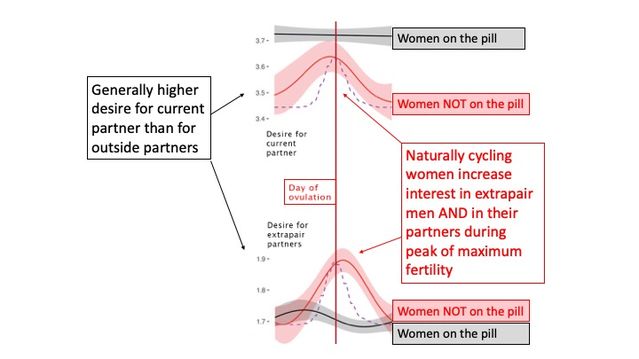Sex
Does Ovulation Change Women’s Sexual Desire, After All?
There is one noncontroversial effect of ovulation on women’s desires.
Posted June 13, 2019 Reviewed by Matt Huston
How does ovulation affect a woman’s desire for sex? This is a controversial question, and it has stimulated debate for at least half a century. When I taught a course in human sexual behavior, way back in the 1970s, many social scientists embraced the Blank Slate view that biology had nothing to do with human sexual behavior. The influential sociologists William Simon and John Gagnon loudly and proudly declared that sexual behavior is a learned script, “entirely historically and culturally determined.” Simon and Gagnon rejected what they regarded as the unproven assumption that sexual drives are fixed biological attributes.
From an evolutionary perspective, though, it would be hard to imagine the natural selection forces that would have led any organism to completely disconnect biology from reproduction. And besides the theoretical problems, what about all those hormones, such as testosterone and estrogen, that have been found to be so important in influencing animal sexual behavior, and are still regularly and abundantly coursing through the veins of human beings? Why would our bodies produce all those hormones if they have no effects?
A correlated belief back in the good old days was that, although many other mammals focused their sexual activities during the period when the female was ovulating, human sexual desire was completely separated from the female menstrual cycle. Those who made that argument pointed out that humans have sexual relations throughout the female menstrual cycle, not only during ovulation, but also during menstruation, when pregnancy is not going to result.
But just because people have sex throughout the menstrual cycle, does that mean that hormonal variations have no influence on human sexual behavior?
There are likely adaptive advantages to continual sexual receptivity in promoting the parental bonds that were important to human evolution: Human babies are especially helpless and needy, and under the circumstances faced by our hunter-gatherer ancestors, anthropologists have found that having a father’s contributions dramatically increases the odds of offspring survival.
But all that says nothing about whether there are remaining influences of hormonal variation on sexual desire in humans. Despite having occasional sex throughout the cycle, women might nevertheless increase their sexual interest and activity during the period of ovulation, thus increasing the odds of pregnancy. If so, that would be important to know, because it would suggest biological influences that are not under conscious control (most women do not know when they are ovulating).
The picture gets more complicated because some evolutionary psychologists, including Steve Gangestad, Martie Haselton, and their colleagues, have presented evidence that women might not only increase their sexual desire during ovulation, but might sometimes direct those desires toward men other than their current partners. They theorize that this is especially true for women whose current partners are not highly physically attractive, dominant, and muscular (these traits are taken to be signals of good genes, in the peacock style).
Like healthy peacocks, the most attractive human males have more sexual opportunities than their less attractive competitors, and for those highly attractive ladies’ men there could be, from an evolutionary perspective, adaptive advantages to devoting their energies to attracting new mates rather than to investing in the offspring. Some females might, on this argument, play a dual strategy, extracting resources from a less attractive male, while actually raising the offspring of one of the more attractive peacock-style fellows.
The results supporting this theory are controversial, and at the recent meetings of the Human Behavior and Evolution Society, professors Gangestad and Haselton exchanged heated words with Lars Penke, one of the authors of a paper claiming that findings supporting their dual strategy theory did not replicate. Gangestad and Haselton claim, on the contrary, that a fair analysis of the existing evidence suggests at least some support.
However, more importantly, and less controversially, another talk in the same session, by UCSB psychologist Jim Roney, presented solid and highly replicable results for another part of the argument against the classic social constructivist view of sexuality as removed from biology.
Whether or not women become more interested in having sex with attractive strangers during ovulation, ovulating women do clearly increase their sexual desire, and they do increase the frequency with which they have sex with their current partners.

The figure presents results from a recently released paper in which the authors examined more than 26,000 diary entries from over 1,000 women reporting on various indices of their sexual interest in their partner and in other men. Some of the women who participated in this study were on the pill, and not subject to the natural cycling of hormones, while others were naturally cycling.
The x-axis depicts the day of a woman’s menstrual cycle, and the red line down the center is the estimated day of ovulation (the dashed lines depict the days of increased fertility). Two things stand out in the figure: 1) women generally report substantially more interest in their current partner than in other men; and 2) women who are naturally cycling (red lines) show a peak in interest in both their current partners and in other men during the days when they are most likely to be fertile.
Women on the pill, as one would expect, show relatively flat trajectories of sexual interest over their cycles (the black lines). This data comes from a paper recently released online at the Journal of Personality and Social Psychology, by Ruben Arslan, Katherina Schilling, Tanja Gerlach, and Lars Penke.
So yes, women do increase their sexual desire during ovulation. And yes, this is important because most women do not know when they are ovulating. When these findings are added to the evidence that men show increased interest in ovulating women, and other findings that testosterone influences sexual desire in both sexes, it is clear that the extreme versions of the Blank Slate social constructivist views of human sexuality, such as Gagnon and Simon’s script theory, were wrong.
References
Arslan, R. C., Schilling, K. M., Gerlach, T. M., & Penke, L. (2018, August 27). Using 26,000 Diary Entries to Show Ovulatory Changes in Sexual Desire and Behavior. Journal of Personality and Social Psychology. Advance online publication. http://dx.doi.org/10.1037/pspp0000208
Roney, J.R. (2018) Functional roles of gonadal hormones in human pair bonding and sexuality. In O. C. Schultheiss & P. H. Mehta (eds): Routledge International Handbook of Social Neuroendocrinology. London: Routledge.
Roney, J. R., & Gettler, L. T. (2015). The role of testosterone in human romantic relationships. Current Opinion in Psychology, 1, 81-86.
Roney, J. R., & Simmons, Z. L. (2013). Hormonal predictors of sexual motivation in natural menstrual cycles. Hormones and Behavior, 63, 636–645.




